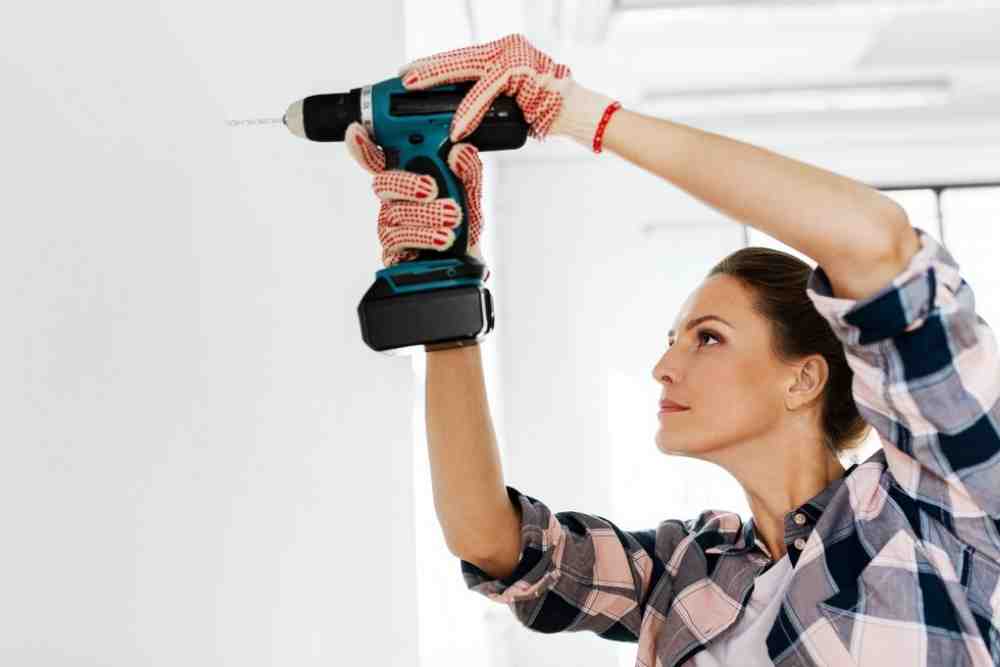Some homeowners own a wide spectrum of power tools, whereas others choose tools geared towards the most frequented projects.
One of these tools is typically a cordless drill.
A standard cordless drill can be used for different purposes in the home to provide numerous beneficial applications, and surprisingly, it may be used to drill into stone or masonry.
While rotary cordless drills are not as efficient as a hammer drill for drilling into concrete, for small-scale projects, where only a small number of holes need to be drilled, a rotary cordless drill is adequate.
If you plan to drill into concrete, you may want to keep reading this article.

What is a Cordless Drill?
A cordless drill is a battery-operated tool that is used to make holes in various materials.
They are commonly used by construction workers, home inspectors, and others who need to make quick, accurate holes.
Cordless drills have a variety of features, including variable speed control and a reversible gearbox.
This type of drill is often used for smaller tasks, such as drilling screws and small holes.
Cordless drills have limitations compared to traditional drills, including the fact that they cannot be used for heavier tasks or drilling in difficult locations.
Can You Use A Cordless Drill For Concrete?
You can use a rotary cordless drill to conduct a selection of holes into concrete. You might also need to use something more substantial than a basic cordless drill if you have to drill more than a few holes.
Cordless drills are designed specifically for light-duty all-purpose drilling and not for repeating piercing through hard surfaces such as concrete, masonry, and brick.
For medium-duty jobs, it’s best to use a cordless drill specifically designed for concrete and masonry.
It’s swifter and much less tiresome to use a cordless hammer drill to drill such jobs.
It is possible that the next step beyond cordless drills is corded hammer drills, especially when working on large concrete projects.
Features Needed for Cordless Drill To Drill Through Concrete
Among cordless drills, some can penetrate concrete more than others. We discuss what makes these drills ideal for drilling through concrete below.
Some of them may seem obvious, while others can go unnoticed, possibly affecting the drill’s functionality while attempting to use it on concrete.
The main features that you should consider when choosing the right drill for a concrete drilling project are:
1. Battery Power
Whether you’re drilling into concrete or not, using a powerful battery can make a difference.
Particularly if you do heavy drilling. Aggressive drilling projects can drain a battery in a matter of minutes, so you must wait patiently until the next charge.
In case you are drilling into rock, you will need a bigger battery. Something like an 18-20 volt battery will do.
Still, most of us will probably prefer a 12-14 volt drill. Lower voltage batteries will work; you will need to exchange the battery quicker.
Most drills will come with two batteries. If that is the case, select a different interchangeable battery so that you may still carry out your work even when one battery runs down.
The batteries are also sold as fast-charging batteries. They will typically provide as much power as regular batteries and last just as long as others.
2. Drill Bit
Choosing the right bit will be essential to the efficacy of your project. You won’t be able to simply use any old bit lying around the tool bench for this task.
When working with materials consisting of concrete and brick, a masonry bit would be a good idea.
The point of masonry bits will have broad, flat edges. The tip of the bit will have a slightly blade-like shape, which gives the bits its distinctive look.
You have never seen or used masonry bits before, which is why it’s essential to know what you should look for when shopping.
You can select from various sizes and shapes when you purchase masonry bits. The most common sizes are 8, 10, and 12 millimeters.
More durable bits will be tipped with tungsten carbide for greater longevity.
3. Torque Settings
The torque of your drill is frequently misunderstood or misunderstood as a major matter or feature.
A common misconception with regard to the torque of your drill is that the higher the torque setting, the faster the drill bit will spin.
The correct interpretation of torque is in regard to the drill’s power, not how fast it spins.
If your drill has alternative torque settings, make sure you use a high torque for drilling through such materials.
Not all drills will have a torque setting, and if this is the case, assume that your drill is set to high torque at all times.
4. Hammer Action
Cordless drills may have a built-in rotating or deconstruction action, and used with a masonry bit, this will help you not only hammer but also turn and drill.
Now you are able to successfully drill into concrete with just the push action on your tool. However, it’ll take you a lot longer, and you’re going to go through plenty of drills along the way.